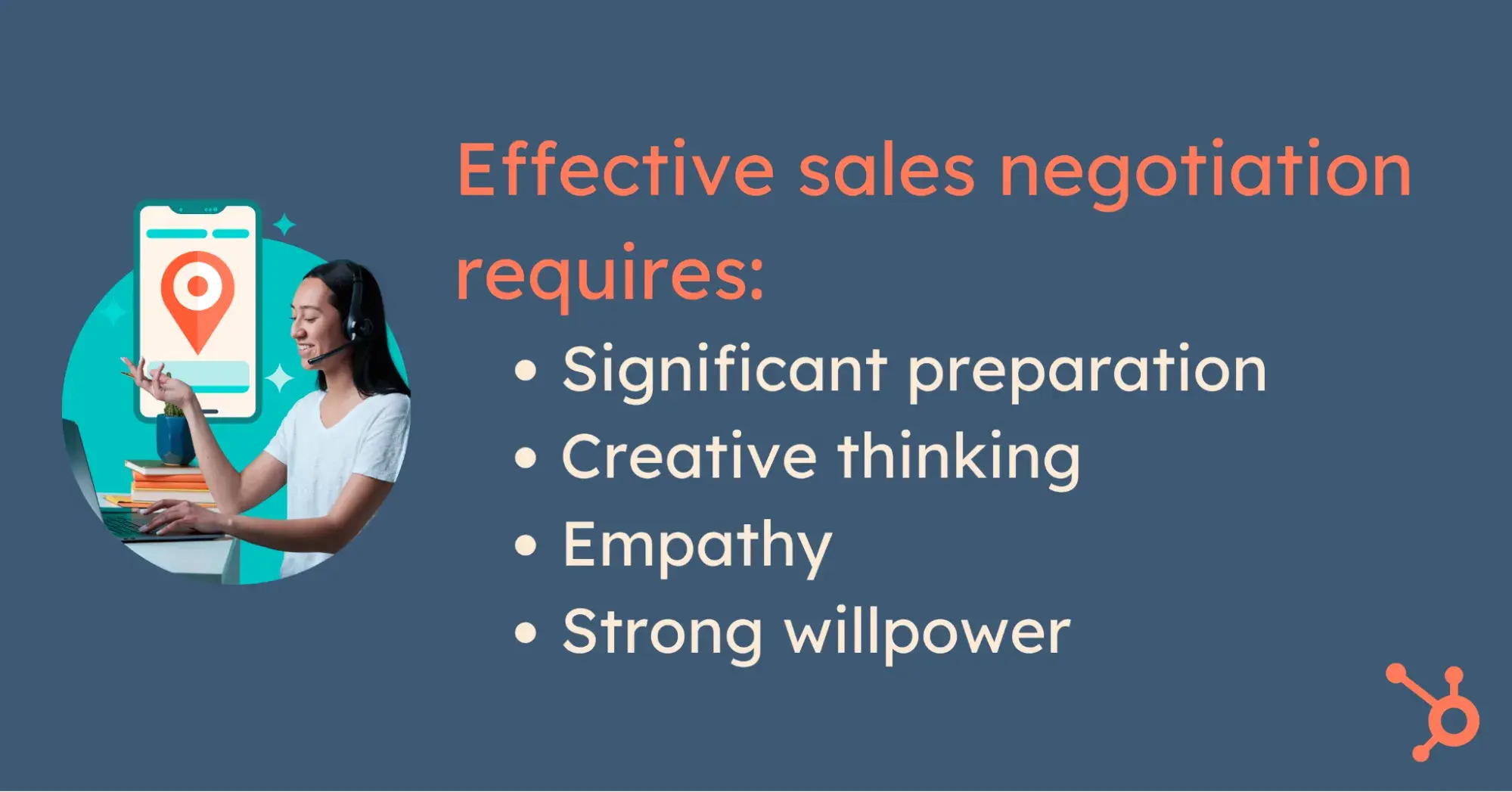Even when you‘ve properly qualified a prospect and carefully managed their expectations through the sales process, the deal can still end in a negotiation. That’s why every salesperson needs to have a solid grip on how to negotiate effectively — from knowing when to hold your ground to knowing when to compromise on price or payment terms to close a contract.
Let’s explore what sales negotiations are. I’ll review why they're important in sales relationships and identify the tactical and strategic skill set every sales professional should develop to succeed.
Table of Contents
Sales negotiations are a collaborative value exchange between businesses (or a business and a consumer). They are sometimes stressful, often frustrating, and occasionally downright disrespectful. Yet, as a salesperson, when my customer signed a contract after a negotiation process and we both felt like winners: the outcome was worth the effort.
However, it’s also important to remember that as a sales rep or sales leader, you want to protect your company’s profit margins and your reputation for value while negotiating.
I remember a few times in software sales roles when customers would purposely ignore me until the end of a quarter — or the year — hoping to use that leverage against my quota to get a better deal. While it was fun when deals would start flowing in at the eleventh hour, if I compromised too much on price (or if being flexible on contract terms prevented revenue from being recognized for the fiscal period), it was a bitter pill to swallow.
Discounting your products or services for a customer can sometimes convey that you will concede your list price every time they do business with you. When you negotiate with prospects or customers, you should always aim for a mutually beneficial outcome where both the customer and the company feel like they‘ve gained value. A win-win scenario helps sales professionals ensure that the customer’s needs are met without sacrificing their company's standards or reputation.

The balance between accommodating your prospect’s budgetary restrictions and bringing in a financially viable deal is a tricky line to toe. Arriving at a mutually beneficial outcome is often easier said than done — especially in an era where buyers are more empowered and well-informed than ever.
In sales, negotiating price and contract terms are simply inevitable, and being an effective negotiator in our age of AI and online negotiation tools is crucial.
Let's take a closer look at why negotiation is so important in sales to grow your business and mitigate your business risk.
Why is negotiation important in sales?
Sales negotiations are valuable in many ways. Here are what I see as the primary benefits.
Effective sales negotiation:
- Establishes trust, credibility, and expectations for each party’s conditions of satisfaction.
- Helps salespeople to tailor contracts like service agreements or proposals to a customer’s unique needs.
- Enables buyers and sellers to agree on terms where both parties can win.
- Builds lasting relationships between both parties by providing a safe space for constructive communication.
During negotiation, sellers must remain composed, consultative, and compassionate. Engaging and fair negotiations can set a precedent that a company is easy to do business with — or that there may be difficulties ahead.

Good sales negotiation strategies require:
- Significant preparation. Understand how flexible your company’s finance and legal teams are about negotiating price and contract terms. Going rogue and agreeing to terms your company won’t live up to isn’t a wise career move. It also erodes trust for future negotiations.
- Creative thinking. Make price discounts conditional on a volume purchase or a series of purchases within a specific timeframe.
- Empathy. Understanding the other party’s emotions and perspective on a purchase can help you find common ground with the buyer. If you detect that the buyer is nervous about making a significant project investment, you can offer information about warranty terms, project oversight, or customer testimonials. Assure the customer that your relationship doesn’t end when the contract is signed. Empaths can probe for underlying concerns or hesitations and address them before they scuttle the deal.
- Strong willpower. Define when a business transaction isn’t worth pursuing. I once had a prospect who was using a trial version of a product for approximately sixty days and was peppering me with technical support questions. I went above and beyond to support their project along the way and ultimately closed the deal, but it was only when I drew a line in the sand that we would turn off their proof of concept system if they didn’t subscribe to the SaaS platform for a year.
It’s like the Kenny Rogers song “The Gambler”: You’ve gotta know when to hold ‘em, know when to fold ‘em, know when to walk away, and know when to run. You may lose a deal or two by holding firm. Yet the customers that are worth winning will respect the value of your products, services, and policies. Compromising too much could also strike the wrong tone for a long-term relationship. Both sides need to have “skin in the game” for a relationship built on trust.
I’ve talked a lot about what makes a negotiation effective, and why you need to know how to negotiate effectively. Next, I’ll review the skills you need to negotiate like a pro.
Sales Negotiation Skills
- Preparation is crucial.
- Clearly define how much latitude you have to negotiate terms.
- Active listening is key to negotiations.
- Negotiate based on specific data points.
- Don’t 'split the difference.'
- Write terms at the right time.
- Negotiating is often a team effort.
- Give to receive.
- Negotiate more than fixed and operating costs.
- Handle objections with diplomacy.
- Stay calm.
- Walk away if necessary.
1. Preparation is crucial.
Don’t go into a negotiation without a standard contract and pricing parameters. If the prospect is well-prepared, and you are winging it, the imbalance of power can undermine your credibility. Negotiating from a position of weakness is risky — even if you close a deal.
You must have an intimate understanding of your prospect‘s business, their pain points, and competitive solutions they’ll consider if your negotiation falls through. You might agree to terms and pricing out of desperation that you wouldn’t have if you had a better sense of what is at stake for both parties.
I once worked with a long-term customer who was looking for a new email archiving solution and needed to buy a considerable number of licenses for the application they were already using. The organization’s CTO said there were some stakeholders in the organization who wanted to replace our technology with a competitive solution, while others wanted to leverage their existing investment in my company’s technology.
The client wanted me to arrange for consultants to interview these stakeholders (at no cost to them) to determine which path forward they should take — and support them through a proof of concept with the email management system.
Now, there were regulatory issues with providing the scope of no-charge service that the client wanted. However, I could provide a promotional discount on the software that was equivalent to the service’s costs they wanted my company to swallow to keep their business. I was prepared with (and approved to offer) this arrangement when I met with the CTO. Ultimately, it extended the company’s relationship with the customer for many years, addressed the issues that the stakeholders were facing, and enriched our relationship with the customer.
During negotiations, you need to have a sense of the best alternative to a negotiated agreement (BATNA) for both parties. It establishes whether a negotiation is worth continuing. If stepping away from the negotiating table helps your business protect the value of your products and enables you to focus on winning other opportunities with less friction, it may be your best move.
Defining the BATNA line is vital for both parties to manage their risk, and to prevent them from entering into deals that incur unacceptable reputational damage or costs. Conduct thorough research to define whether a sale is worth winning based on a customer’s non-standard demands.
2. Clearly define how much latitude you have to negotiate terms.
Know your company’s sales strategy inside and out.
In the heat of the negotiations, a 30% discount might seem perfectly acceptable. Yet if offering that deep a discount is against your company’s policy, or above your paygrade, then doing so could prevent a deal from being fulfilled.
Clearly understand and define what your limitations are on price discounts and term modifications before you meet your negotiation partners at the table. Agreeing to a deal you can’t live up to is worse than not coming to an agreement at all.
I learned this lesson well from the Open Text sales operations team, and I’ve adhered to it since. You don’t have to commit to terms or pricing live on the phone. You can always flag a term the prospect finds problematic and have your colleagues in legal or finance decide whether to modify the term or keep it.
3. Active listening is key to negotiations.
Sometimes, when you present the terms of the deal, the prospect will counter your terms to their considerable favor. You are sometimes better off letting the buyer start the conversation.
Salespeople are often tempted to immediately jump in and offer a discount or terms adjustment in the interest of being accommodating. But there's a line between being accommodating and being overly eager.
It pays to listen first and speak second during negotiations. You can‘t know what your prospect is thinking if you don’t let them present their perspective. Stay composed, have them reveal where they stand in the conversation, and use silence to your advantage.
In other words, follow the 70/30 rule of sales communication and listen more than you speak. Find opportunities to concede where it doesn’t cause your company undue risk or erode the value of your products or services. The best negotiations are when both parties win.
Silence can also be advantageous in sales negotiations after submitting a proposal. Silence communicates confidence and strength. It allows both parties to think through their next move and gives customers the opportunity to accept your offer or state any concerns they need to be addressed. Your price may be well within a customer’s range, but second-guessing your offer to break the silence can indicate that you question whether your pricing suits the value of what you have to offer.

4. Negotiate based on specific data points.
If the customer would like money knocked off your product‘s price tag, don’t offer a range of options. If you say something like, “Well, I could probably reduce the cost by between 15 and 20%,” you're setting yourself short by suggesting your lowest acceptable price.
Who would accept 15% when 20% has been offered? Always quote one specific number or figure and then go higher or lower as necessary. The word “between” should be avoided at all costs.
Ambiguity is not your friend in sales negotiations.
5. Don’t “split the difference.”
Offering to “split the difference” on pricing can seem like a clean, easy way to arrive at an agreeable deal, but it usually does more harm than good.
For example, if your product or service costs $10,000 and the prospect wants a 50% discount, don’t counter with $7,500 to try and reach a quick settlement. It might seem fair and mutually beneficial, but those kinds of discounts are often rash and over the top.
When you offer a moderate discount that is close to your original price, the prospect may accept it because you are maintaining your position of strength — and you protect your profit margin. Don’t be afraid to use your company policies to hold firm in negotiations. Check in with your chain of command if the buyer insists on further concessions, but be prepared to walk away from the deal if an executive decision is made to stick to your offer.
6. Write terms at the right time.
Negotiations are often complicated. Offers and counteroffers or redlined terms can go back and forth multiple times in negotiations over complex agreements and high-value transactions. They often require representatives from legal and finance teams from both parties to navigate through to a mutually beneficial arrangement that protects both parties’ interests.
Several options will be proposed. Some conditions will be accepted, and others will be denied. That‘s why you don’t want to commit anything to writing until the meeting has ended — wait until all parties have verbally agreed to terms before you draft and table a legally binding contract.
7. Negotiating is often a team effort.
This tip might seem obvious, but many salespeople make the mistake of negotiating with the wrong person, or they try to negotiate a deal alone that requires oversight from multiple stakeholders.
A company can have several people who might come to the negotiating table without the authority to actually make business decisions. I was always happy to have a legal counsel, my sales manager, or a services principal on contract negotiation calls to ensure the right guardrails were in place to negotiate the best deal for the customer and my employer.
Free Resource: Get your call off on the right foot with these free call scripts.
If your customer has multiple executives from their leadership or legal team at a meeting or online conference, rally equal representation from your team to level the playing field. You can lead the conversation as far as you are able, and gracefully step back and allow your team to contribute as their roles dictate. Executives often like to sit at the negotiation table with their counterparts in your company when negotiating a strategic investment. See the move as relationship-building instead of compromising your control of the negotiations.
8. Give to receive.
Healthy salesperson-customer relationships are borne out of mutual respect and trust. They're not a matter of salespeople bending over backward to accommodate buyers at every turn.
That‘s why salespeople shouldn’t accept every prospect's demand without making some of their own. By keeping the negotiation a win-win for both sides, the salesperson and client remain on equal footing, which lays the groundwork for a productive relationship.
Recently, I’ve been working as a senior proposal writer for a business that serves airports, mixed-use commercial buildings, hospitals, and universities. I’ve worked on and participated in deals where the proposed terms and pricing aren’t the ultimate terms and price.
Even after my company had been selected as the customer’s first choice for strategic deals, the customer asked for a BAFO proposal, or Best and Final Offer. Sometimes, price changes; in other cases, it’s contract terms or products or services. It certainly keeps things interesting down to the final sign-off.
In these circumstances, concessions are often necessary to secure a signed contract and the beginning of a lasting relationship.
9. Negotiate more than fixed and operating costs.
The most commonly negotiated aspect of a sales deal is price, so salespeople should be prepared to talk about discounts — but discounts aren't the only way sellers can sweeten the pot.
Price is tied to value, and value is tied to a customer‘s perception of and satisfaction with a product. That’s why you might want to consider offering other add-ons or freebies to a deal in lieu of a smaller price tag.
That being said, this isn‘t a hard and fast rule. It’s all situational. Sometimes a discount is the best course of action. If you make concessions, you need to consider the circumstances of the deal holistically — additional perks won't always be more appropriate than hard financial concessions.
10. Handle objections with diplomacy
As a salesperson, handling objections is critical to every conversation you have.
Make sure you are clear on what a prospect is objecting to by confirming it back to them and then addressing it. (You can find more insights on expert objection handling by visiting this article on the HubSpot Blog.)

11. Stay calm.
Composure is key when participating in negotiations. Getting flustered or frustrated can turn your prospects off and undermine your ability to frame yourself as a helpful, agreeable, and consultative resource.
Remember that negotiation is, in large part, a relationship-building process. If you lose your cool, your prospects will be less inclined to form a long-term, productive partnership with you. Always keep your cool — for everyone's sake.
12. Walk away if necessary.
Salespeople shouldn‘t be willing to accept any curveball a prospect throws at them. If demands become unreasonable or unprofitable for the company, don’t be afraid to walk away from the deal.
A customer who only agreed to sign if the contract was radically amended or the price was drastically dropped is bound to cause problems down the road.
Those kinds of changes also often signify that the prospect doesn‘t see much value in your offering. That means it’s only a matter of time before they become dissatisfied. Use your instincts, but also know the signs, and be able to walk away when necessary.
Thriving in Sales Negotiation
As I mentioned at the beginning of this article, negotiating skills are essential for success in the sales profession, but they can be challenging to develop without training and experience. I hope the information I shared here will help elevate your sales negotiation strategies and skills.
Maintaining composure, listening with empathy, understanding your offering's value, and making silence your ally can help you thrive in sales negotiations.
Editor's note: This post was originally published in March 2015 and has been updated for accuracy and comprehensiveness.
Sales Negotiation







.jpg)

